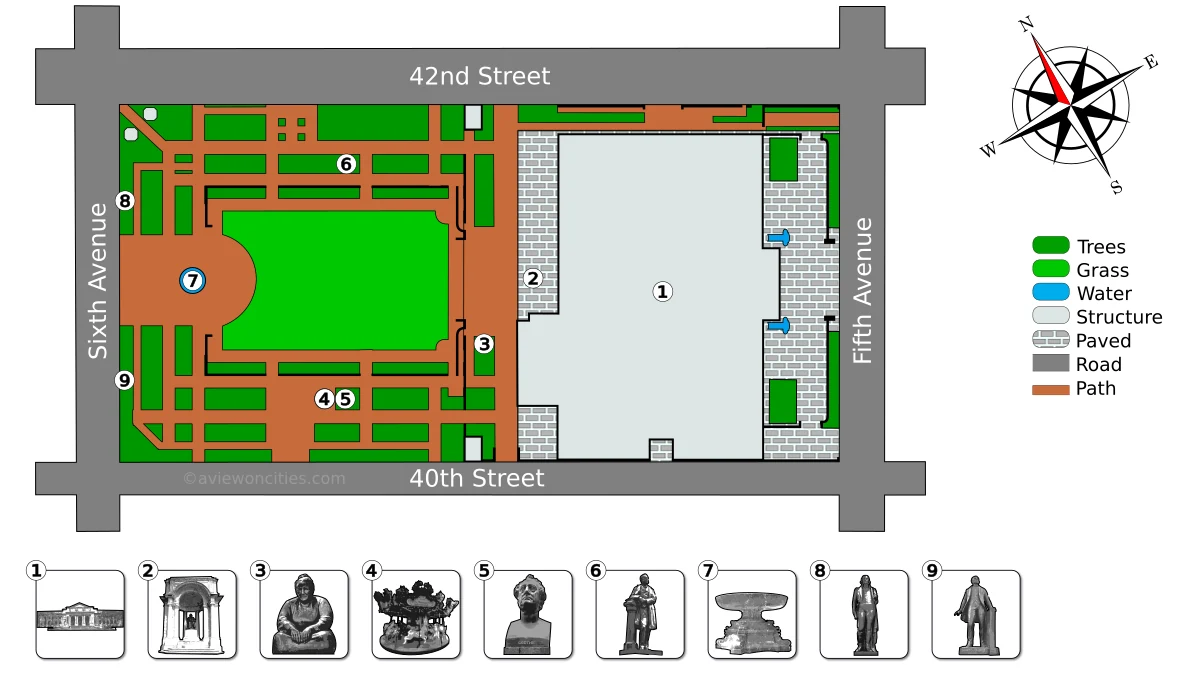Bryant Park, an almost ten-acre-large (3.9 ha) green oasis at the intersection of 42nd Street and Sixth Avenue, is one of the most pleasant parks in Manhattan. Even though the park is bordered by heavily trafficked streets, it is a very inviting park with lots of places to relax or enjoy a snack with a fresh brew.
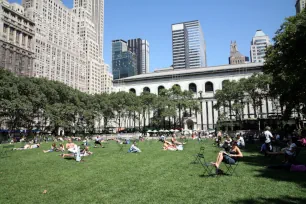
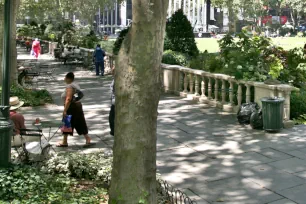
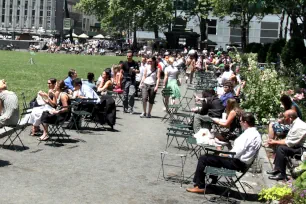
Bryant Park has a simple but effective layout, with a large, central lawn surrounded by trees. From the park, you have an excellent view on some great architectural landmarks, including the former American Radiator Building. And similar to some Parisian parks like the Luxembourg Gardens, you can take one of the 2,000 available chairs and sit wherever you prefer.
History
Reservoir Square
As New York expanded northwards, the plot on which Bryant Park sits became part of the city in 1822. Shortly after, the city of New York designated this plot as a potter’s field (a burial place for paupers). The construction of the Croton Reservoir – which supplied the city with drinking water – right across the street made this place unsuitable for a graveyard, so it was cleared and in 1847 was turned into a square known as Reservoir Square. In 1853 the first American World Exposition was held here in Crystal Palace, a magnificent glass construction. Five years later, the palace was destroyed by fire.
The square becomes a park
In 1884 the square was renamed Bryant Park after William Cullen Bryant, a poet and lawyer. He was one of the most influential advocates for abolition of slavery in the United States, and one of the forces behind the creation of Central Park. He is honored with a 1911 statue that overlooks the park.
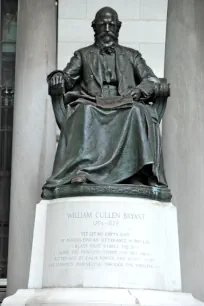
In 1899 the reservoir adjacent to Bryant Park was demolished and replaced by the New York Public Library. During this construction, which would last until 1911, terraces and kiosks were constructed at the park.
1930s Redesign
After several decades of neglect, the park was redesigned between 1933 and 1934 as part of the depression-era public works project. The competition-winning design by Lusby Simpson was implemented by Robert Moses. It featured a great lawn and hedges which obscured the views from the surrounding streets.
Two years later, an iron fence was constructed around the park. This design resulted in a public space virtually cut off from the surrounding city life. You could pass the park unaware of the activities within. This made it appealing for drug addicts and in the seventies and eighties, the park was shunned by most citizens and tourists.
1970s to Today
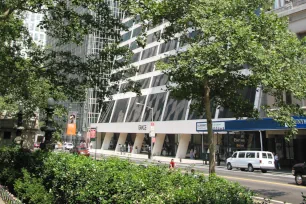
In the 1970s, the Bryant Park Restoration Corporation was founded by the Rockefeller Brothers. This led to a privately-funded redesign and restoration in 1988. The redesign by landscape architect Hanna/Olin and garden designer Lynden B. Miller was aimed towards restoring activity in the park. The high hedges were replaced by shrubs, opening up the park towards the streets.
In 1992, the new Bryant Park officially opened and became an instant success. It is now one of New York’s most popular parks. In 2002 the park became the city’s first ‘wireless park’, which means you could connect wireless to the internet from anywhere in the park.
Sights
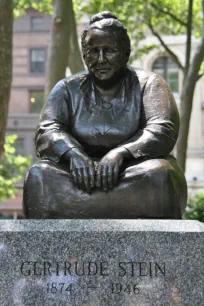
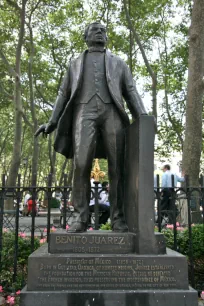
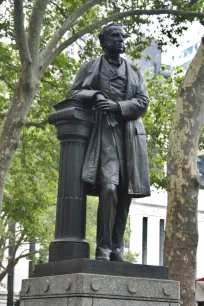
Statues
There are several statues in and around the park. The most impressive is that of William Cullen Bryant, after whom the park is named. It occupies a prominent spot on the rear terrace of the library, from where it overlooks the park. The bronze memorial was designed by Herbert Adams, an American sculptor who was classically trained in Paris. It was inaugurated here in 1911, the same year the public library opened. The memorial shows a larger-than-life elderly depiction of the American poet and lawyer, who is seated on an ancient Greek chair, set on a marble pedestal designed by Thomas Hastings. Hastings also designed the monumental half-dome that arches over the statue.
Nearby is the life-size statue of Gertrude Stein, another American poet. The statue – which shows her in a Buddha-like pose – was created in 1923 in Paris by the American sculptor Jo Davidson, who was a friend of Stein. The statue in the park is a cast of the original that was installed here in 1992.
On the opposite, west side of the park stand two statues that face away from the park towards Sixth Avenue. The one near the northwest corner is the most recent one. The bronze statue was created in 2002 by Mexican sculptor Moises Cabrera Orozco and installed here in 2004. It depicts Benito Juárez, a Mexican statesman. The statue was a gift of the Mexican state of Oaxaca to the city of New York.
The other statue facing Sixth Avenue is situated near the southwestern edge of the park. It was also a gift, from the people of Brazil, and placed here in 1955. It depicts the Brazilian statesman José Bonifacio de Andrada e Silva. The statue is one of about six statues of leaders of the independence movement of Latin America near Sixth Avenue, which in 1945 was renamed «Avenue of the Americas» to honor Pan-American ideals. The bronze statue is the work of Brazilian sculptor José Otávio Correia Lima.
In the middle of the northern half of the park stands a beautiful bronze statue of William Earl Dodge, a local businessman and politician. The statue was created by John Quincy Adams Ward and cast in 1885. It shows Dodge leaning on a podium while delivering a speech.
There’s also a bust of the famous German writer Johann Wolfgang von Goethe in the park. It was created in 1832, the year of Goethe’s death, by the German sculptor Karl Fischer. The bust was donated to the Metropolitan Museum of Art who, in turn, donated it in 1932 to Bryant park on the occasion of the centenary of the writer’s death.
Fountain
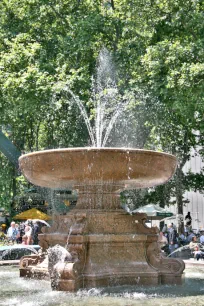
The west side of the park features the Josephine Shaw Lowell Fountain. Built in 1912 and designed by Charles Adams Platt, this was the first monument in New York dedicated to a woman. Lowell (1843-1905) was a pioneering social reformer.
The basin of the fountain is 32 feet or about ten meters wide. At its center stands a large 13-ft-wide (4m) pink granite bowl, which rests on an ornamental base. A large water jet shoots water up into the bowl, from where it spills into the basin. There are also several spouts integrated in the base of the fountain.
Carousel
In 2002 a carousel with fourteen colorful animals for riders was added to the park. The custom-built carousel, named «Le Carrousel», was made in Brooklyn after a design by Marvin Sylvor in the traditional style so it looks like a vintage, almost antique, Parisian carousel.
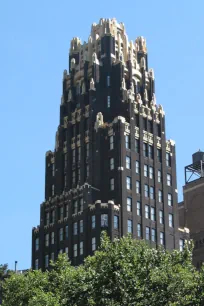
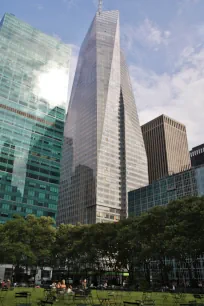
Surrounding buildings
Bryant Park is hemmed in by some great landmarks. On the east side of the park is the 1911 New York Public Library. This magnificent Beaux-Arts building was designed by Carrere & Hastings. The library’s entrance is at Fifth Avenue; from Bryant Park, you look onto the back side of the building.
Just north of the library is 500 Fifth Avenue, a 212-meter-tall (697 ft) skyscraper built in 1931 for Walter J. Salmon. It was built after a design by Shreve, Lamb & Harmon Associates, the same architectural team responsible for the Empire State Building, which was built that same year.
Another building of interest is the former American Radiator building – now Bryant Park Hotel, a great 1924 skyscraper in Neo-Gothic style with Art Deco ornaments. The 22-story tower was designed by André Fouilhoux and Raymond Hood; the latter is also known for the Tribune Tower in Chicago.
Another landmark near Bryant Park is the 1901 Bryant Park Studios, a building on 40th Street in Beaux-Arts style. On the other side of the park is the more modern and larger W.R. Grace Building, a sleek 50-story building designed by SOM’s Gordon Bunshaft. It was constructed in 1974 for the W.R. Grace chemical company. Adjacent to the W.R. Grace Building is an even larger skyscraper: the 288-meter-tall (945 ft) Bank of America Tower, completed in 2009.
Map of Bryant Park
